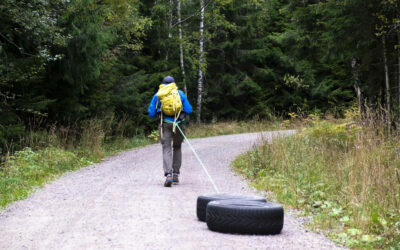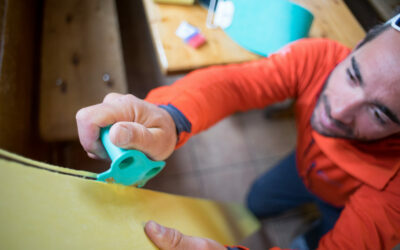Preventing problems with skins
Skins open the door to wonderful experiences in nature. When they fail, though, it’s very frustrating. Luckily, with proper treatment, storage, and a few tricks, your skins will last forever and won’t let you down when you need them.1. Keep the glue clean and dry
One of the most important rules for keeping a skin alive is, of course, to keep the glue away from dust, dirt, gravel, dog hair, carpet and anything else that can get stuck in the glue.2. Brush snow and ice off the adhesive – and stick again
Snow and ice can get on the adhesive in the mountains. It happens. You can just brush it off with a glove if it’s not too bad. Or you can scrape the skin over a steel edge. Or, circumstance allow, you can simply fold them up and put them in your inner pocket so that the snow and ice melts, the skin glue warms a couple of degrees, and the skin might dry a little.3. Cold = less stick power
Spare a thought for cold skins. When it’s really chilly, skins can get stiff. The adhesive loses some stick power. If it gets really bad, the skin might not stick to your base at all. At which point, it’s a good tactic to put the skin in a pocket next to your body, returning it to a clean base once it’s been warmed by body heat. On longer days in around -10° to -15° temperatures, it’s a good idea to stick skins into an inner pocket every time they comes off (assuming they fit).4. Good routines
Skin adhesive fails at the rear tip first. It might get iffy at the front attachment, too. Snow, ice, water and sundry trail goo get in where the skin isn’t completely flush with the base and where there’s the most friction. Check the skins regularly. Remove plant matter and other things that get stuck in the glue. Keep the skin in the inner pocket if necessary. Also bring skin wax to prevent the fibres from absorbing moisture. A tube of skin glue for spot-repairs in the cabin isn’t the worst idea either.5. Crisis solutions
If you get into really big trouble, a ski strap, gaffa tape or sports tape can save the day. Or, at least, get you out of the mountain. Note: gaffa tape is not a reasonable substitute for an appropriate routine!6. A dry skin is a good skin
Wet snow, the kind you find on warm days and the last weeks of the season, can lead to very damp skins. These are the conditions where glomming – the unwanted accumulation of frozen shite on your skins – occurs. Especially if the temperatures fluctuate. This is where the skin wax comes into play. Bring skin wax. Always bring skin wax. It can, and has, saved many a tour. It’s so small. It allows skins to work. Actually: you can also put glide wax on skins in pretty much the same way you would on your bases. It staves off wear on the skin, adds water resistance, and adds to the glide. (If you want to remove it, you can use base cleaner and a cloth – never let base cleaner get on the adhesive. When you’re not using your skins, they can be dried and heated in the inner pocket. Again, good routine and preparation are everything. Treat your skins to a good waxing before you go on a trip or at the start of the season!7. Globbing, begone: no ice please
OK, so – you forgot to wax and your skins are covered in ice. Well, no one’s perfect. All is not lost. First, scrape away what you can using a steel edge, a wax scraper, or whatever you have to hand. The old iPhone 5. Leave the skins on. Try to scrape from the front tip all the way back to the rear tip. You’ll probably be able to squeeze and scrape enough out. If it’s sunny, you can put the skin in the sun with the problem side facing the sun. They might dry out a little when you have your sandwiches. Finally, you should apply skin wax – and LOTS of it. If you don’t have any to hand, use what you have. Vaseline. Sunscreen. Silicone. Cooking oil. When you clean it off, don’t spray base cleaner on to the skin – use a rag.8. Always dry skins – at room temperature!
All wet equipment should be unpacked and dried. This is particularly important for skins, because, as we say in Point 6, a dry skin is a happy skin. However, skins should NOT be exposed to direct heat. Don’t put them on heated floors, or near a stove. Hang them on a drying line at normal room temperature. When dry, store them somewhere cool, away from sunlight. A cellar, a garage – somewhere like that.9. Storage
Most of us store our skins stuck glue-to-glue. But when skins are to be stored for a long period, over the summer for example, it may be good to use a mesh skin-protector between them. Just to be safe. Again, store your dry skins somewhere cool, away from sunlight. In the cellar or in the shed.10. Re-glue your skins when necessary
Sooner or later, glue wears out. It ages; in the end it’s just had enough of snow and fingers and grip wax and being dried above a wood-burning stove in the cabin. This doesn’t mean that the skin’s finished, though: skins get better and better with use. Re-gluing a skin takes a little time from your afternoon, but there are several methods now. And glue’s much cheaper than a pair of mature skins with stories to tell.
Tyre training
Get started with tyre training – the best way to prepare for an expedition or the coming ski season.

Preparing for Åsnes Expedition Amundsen
Dreaming of an adventure in the winter mountains? Or a lover of endurance races? Maybe Åsnes Expedition Amundsen is for you. But you’ll need to be ready.

Tips for taking a dog into the wilds
Positive training and positive experiences in the outdoors make for a confident dog. But setting out in winter is something a little different – especially if you’re overnighting. So we’ve put together some good rules, tips and tricks to make the experience the best it can be. There’s nothing to prevent these tips being applied in your everyday life with your dog, either!

Boots for cross-country skiing in the backcountry
Nothing ruins the skiing experience as effectively as foot-related woe. Blisters. Wet socks. Sore arches. These things are the enemy. Good ski boots are incomparable – cherish yours once you’ve found them. Here’s a guide to help you find them.

Which cross-country skis? And how long?
Choosing new cross-country BC skis is can be bewildering. We compare length, width, profile. We weigh ourselves and check again. We ask advice on forums. We change our minds repeatedly. So before you pull the trigger, set your mind at rest by reading this overview. If you’re still unsure, you can talk to the expert in your local specialist shop or contact Åsnes’s customer service – we answer questions the whole time and we can usually help!

Tailoring long skins for alpine touring
Wondering how to tailor your skins for alpine touring? Here’s an overview – care and trimming long skins for touring skis.